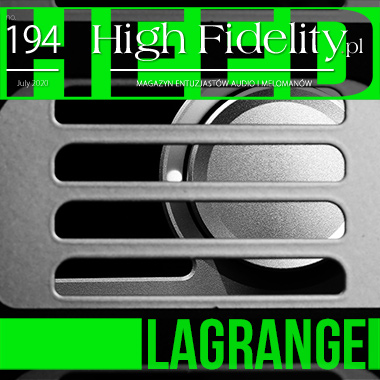No. 257 October 2025
- COVER REVIEW: ANCIENT AUDIO Silver Grand Mono Mk II ⸜ power amplifier • monoblocks » POLAND • Kraków
- KRAKOW SONIC SOCIETY № 153: 30 years of ANCIENT AUDIO » POLAND • Kraków
- FEATURE ⸜ music & technology: HISAO NATSUME presents - In search for the lost great pianism Chopin tradition » part 2 (France) » JAPAN • Tokyo
- REVIEW: AUDIOPHONIQUE Classic AP 300D ⸜ power amplifier » POLAND • Pruszków
- REVIEW: AVATAR AUDIO Holophony No. 1 ⸜ loudspeakers • floor-standing » POLAND • Osowicze
- REVIEW: DIVALDI Gold PA One ⸜ integrated amplifier » POLAND • Kraków
- REVIEW: J.SIKORA Aspire ⸜ turntable (deck + tonearm) » POLAND • Lublin
- REVIEW: MB AUDIO CABLE Silver ⸜ analog interconnect ⸜ RCA » POLAND • Turza Śląska
- REVIEW: XACT N1 ⸜ LAN switch » POLAND • Wrocław


|

|
|
WHY DO WE NEED EXPERTS (now!)

A fragment of a lawn with self-sown plants - but this is what 'field' lawns look like, ones that do not have to be mowed. Sounds familiar? This is a fragment of Robert Harris dystopia titled Second dream, which shows the world after an unspecified catastrophe (the book was published by Albatros in Poland). Although it is a literary fiction, it has scientific foundations and there is a common consensus regarding the possible threats 21st century man faces. Have you notice that the climate is mentioned twice? - And for good reason. 
Art Nouveau tenement house designed by Alfred Kramarski from 1912, 47 Łobzowska Street (Kraków). On the walls there are visible floral motifs, sunflowers - what an irony: neither on the balconies, nor on special elements by the windows there are no flowers Until recently, the world we live in - I mean the Eurocentric world, because I do not know another ones so well - seemed to be taking a course on "despite knowledge". Although we pretended that knowledge is important, education is important, what experts say is important, in fact, in our hearts of hearts we thought that only we know the truth, we know everything about everything. Politicians only confirmed it, undermining the opinion of any scientist, if their opinion casted even a shred of doubt on what these politicians claimed. In a word - we lived despite science, despite knowledge, despite the expert opinions. That is until the pandemic came. Although in its time many conspiracy theories are doing very well, for many who previously winked knowingly, if only the words were spoken, which they did not understand - which was supposed to mean "I am just like you, I do not understand this gibberish" - a warning sign turned on. Suddenly, it turned out that it is impossible to "invent" ways of dealing with the coronavirus, it is impossible to "decree" the spread of the pandemic, it last but not least it’s impossible to determine at a party's leadership meeting when will it all end. 
People turned to experts, because our lives literally depend on them. Their impact on what is happening around us is best seen in those countries that are doing the best with pandemics, such as New Zealand, Taiwan, Singapore, Sweden and Germany. And they achieved that despite the fact that they have adopted very different models of dealing with the pandemics. Because although there is no one truth, the goals are real and the same, and only the ways to achieve them and the means at disposal may differ. When take the decision making from experts it usually ends with difficult to explain moves, unclear purchases, dirty licks and so on. It all came to my mind when I saw that in front of my window, in the middle of a drought, a team taking care of greenery, mowed the lawn. The effect was easy to predict, because within a few days it turned yellow and a large part of the soil became dry. I was furious, because the fact that one should not mow the grass "to the ground", and it would be best not to mow it at all, has been shared by numerous experts for several decades. As you can see - in vain. And the lawn as a phenomenon originates directly from the owner’s, aristocrat’s hubris. At a time when land had the highest value, planting space in front of the manor with grass, not edible plants, was a declaration of wealth and at the same time the last degree of contempt for those who had nothing to eat. This is where the lawn in front of our houses, buildings and public spaces comes from. We keep going with this unfortunate symbolism without even knowing it. And there's an even more basic problem involved here - mowing the grass dries the ground. And we live in a country (I am thinking of Poland) that has the least water supply in Europe, almost equal to African countries. Making sure that as little water evaporates as possible should be something all of us understand and do without even thinking about it. The same goes for taking care that the water from the rivers does not flow straight into the sea, but stays between the spring and the see for as long as possible and that it evaporates over the land. And here comes a tractor and eats a piece of vegetation that has survived so far to the ground. |

Stanisław Worcell str. 10 (Kraków) and a tenement house from the 1930s. Corner flower baskets have classic shapes of the pre-war modernism. They are obviously empty. A way to solve this problem are the so-called "meadow lawns." A few years ago in front of the National Museum in Krakow, the nearby University of Agriculture sowed an experimental "lawn", which instead of grass featured plants known from the meadows, i.e. flowers, low perennials, herbs. Such a "lawn" does not need to be mowed and it does not overgrow the trees. That was about five years ago, and so far maybe a dozen or so small pieces of land have been planted in Krakow in this way - at tram tracks, and in several parks. And that was it. Even that experimental meadow from the museum front disappeared. So there is an unbelievable discrepancy between what we know and what we do. Expert knowledge is something distant to us, unless - as in the case of the pandemic - it does directly and irrevocably affect us. There is a lot of talk about "vertical cities" in which all horizontal spaces would be used to plant some plant vegetation - also edible - futuristic ideas are pumped up, but simple easily available solutions are overlooked. Like an issue of rainwater. It should be accumulated in tanks and used to irrigate the vegetation with it, and after some filtration it could be used to flush toilets. Simple right? - We could save money and water. And the truth is that - if I understand correctly - in the recent years there has not been built a single multi-family residential building in Poland, which would be equipped with this type of installation. And we live in concrete heat islands ... Speaking of "islands" - the need to introduce greenery to cities was already known at the beginning of the 20th century. Many Art Nouveau and then modernist tenement houses built back then featured balustrades on balconies, an integral part of which were metal flower baskets. Some buildings had planty of them. During my last weekly Saturday walk around the city, I noticed what was left of this idea. 
A corner tenement house Pod Pająkiem erected according to the design of Teodor Talowski in 1889 - 35 Karmelicka Street (Kraków). When I say nothing, just NOTHING, is left will you be surprised? Krakow is doing quite well with the renovation of tenement houses. Many of them are beautifully restored and who knows, maybe they even look better than the day they were erected. So what? - Not one of them is "bathing" in the flowers. Not just that - none of them has any flowers in any baskets in question, no plants whatsoever. The baskets are apparently treated as part of the ornament, not as an integral part of the design of a given building - and they were designed so that the stone was cooled with green plants. That is why it is so difficult for me to look at the building at 35 Karmelicka St. In 2000 it was restored and it looks impressive. It features a sundial (unfortunately faulty from the beginning) and a large spider at the very top. Its walls are not smooth, and they feature a lot of protrusions, bumps. In a word - it's good. Until one realizes what we lost with the renovation. The tenement house bearing the name Pod Pająkiem (under a spider) was built according to the design of Teodor Talowski in 1889 for the architect's family residence. And he was one of the most interesting designers who left a lot of his works in Krakow, with the largest example being a group of tenement houses at Retoryka Street. But I wanted to mention something different - an ivy grew on the building’s wall for years. These protrusions and bumps were designed so that the plant could easily climb up using them and that it was also a natural irrigation. Today, it’s all gone. 
The bumps on the walls were designed for the ivy to climb up using them. Renovated, cleaned and... empty. And experts have been saying for decades to add as much green vegetation to the city as possible, right? And it's not only about aesthetics, but also about survival. However, as long as experts will lose to internet trolls, half-idiots who just have some free time and high speed internet access, with people who have an interest to keep the status quo, we will keep being "wise after damage is done" , if there even is any "after". And it's not just the lawn issue, it's a common problem. Do you think that audio is different? - Think again: why should our industry be unique in this respect? That is why we need experts in every field, we need them more than ever before. The worst that could happen to us, audiophiles is that we will listen to the music using some crappy audio systems - it won’t kill us. But without water, yes, we will die. Very quickly. WP |
About Us |
We cooperate |
Patrons |
|
Our reviewers regularly contribute to “Enjoy the Music.com”, “Positive-Feedback.com”, “HiFiStatement.net” and “Hi-Fi Choice & Home Cinema. Edycja Polska” . "High Fidelity" is a monthly magazine dedicated to high quality sound. It has been published since May 1st, 2004. Up until October 2008, the magazine was called "High Fidelity OnLine", but since November 2008 it has been registered under the new title. "High Fidelity" is an online magazine, i.e. it is only published on the web. For the last few years it has been published both in Polish and in English. Thanks to our English section, the magazine has now a worldwide reach - statistics show that we have readers from almost every country in the world. Once a year, we prepare a printed edition of one of reviews published online. This unique, limited collector's edition is given to the visitors of the Audio Show in Warsaw, Poland, held in November of each year. For years, "High Fidelity" has been cooperating with other audio magazines, including “Enjoy the Music.com” and “Positive-Feedback.com” in the U.S. and “HiFiStatement.net” in Germany. Our reviews have also been published by “6moons.com”. You can contact any of our contributors by clicking his email address on our CONTACT page. |
 



|
   |
main page | archive | contact | kts
© 2009 HighFidelity, design by PikselStudio,
projektowanie stron www: Indecity










